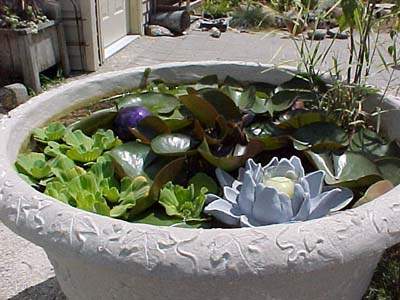
Plant Profile: Water Lettuce
By Josh Spece
Common Name: Water Lettuce
Latin Name: Pistia stratiotes
Hardiness: zone 10
Light: Does best with shade during the hottest part of the day, but can adapt to full sun.
Size: Individual rosettes can range from 2” to 18” across.
Notes: Water Lettuce is a floating plant from Tropical America. It’s thick, fleshy, light green leaves are heavily ribbed and form a rosette that looks like a small head of lettuce. The leaves are covered in tiny hairs that repel water. Like the water hyacinth, water lettuce is a vigorous grower and can form large mats that choke out other plants. It should never be released in a natural body of water and is outlawed in some southern states.
Water lettuce is grown for its foliage, but it does bloom. The insignificant flowers are usually hidden down between the leaves.
Being a floating plant, water lettuce obtains all it’s nutrients directly from the water. This makes it a great plant to use to combat algae. The long feathery roots also make great shelter for young fish and other wildlife.
Water lettuce is generally care free, but there are a few reasons it may not thrive. Fish love to nibble at the roots and if they are large or there are a lot of them, they may kill the plant or even eat the entire thing. Placing the lettuce in floating baskets or partitioning them off from the fish with rocks may help.
Lettuce loves to be crowded and even though they are floating plants, they don’t like to drift around. Corralling them with a hoop of plastic tubing, a hula-hoop, fishing line, or even rocks will keep them from moving around. Water lettuce also does not like to have water on its leaves.

Lack of nutrients will cause water lettuce to grow poorly and turn yellow. Lettuce is such a vigorous grower it sometimes uses up one or more nutrients in the pond. This can especially be a problem in very small ponds and ponds with very few fish. There are two ways of fertilizing your lettuce. If you only have a few, you can float them in a bucket of Miracle Grow for a few hours at a time. If you have too many lettuce to remove from the pond, you can treat the entire pond with a solution of Muriate of Potash. Flora Boost is a commercially produced potassium supplement. Lettuce and other floating plants also usually respond well to any of the micro nutrient solutions specially made for pond plants.
Another problem can occur if you try to ship water lettuce during hot weather. You will end up with a head of lettuce and no roots. Float the plants in a shade spot and they usually grow new roots very quickly. Adding a little fish emulsion to the water (not in the pond!) may help, too.
Varieties: There are a couple different varieties of water lettuce that water gardeners may be interested in. The two most common are the Ruffled Water Lettuce and Jurassic Water Lettuce. ‘Ruffles’ has more wavy leaves and doesn’t grow as large as the other varieties. It is perfect for small container ponds. Jurassic Lettuce is a large form that can grow to be the size of a dinner plate. It doesn’t seem to grow as fast as the common variety. ‘Splash’ is a variegated form that stays smaller. It is still very hard to find.
Winter Care: Trying to overwinter water lettuce in cold regions is usually more hassle than it’s worth. They are cheep enough and grow fast enough during the summer that it is usually easier and more cost effective to buy new ones each spring. If you want to try keep lettuce over winter it needs a warm spot that is brightly lit. A South window is best, but artificial lighting may still be necessary. Fluorescent shop lights 6” above the plants is about right. Some people have reported success by putting a couple inches of compost in the bottom of the container the lettuce is in. Others actually pot the lettuce and submerge the pot so the rim is an inch or two below the water surface.
Propagation: division of daughter plants
All content and images © 2025 by In The Country Garden & Gifts unless otherwise noted.

